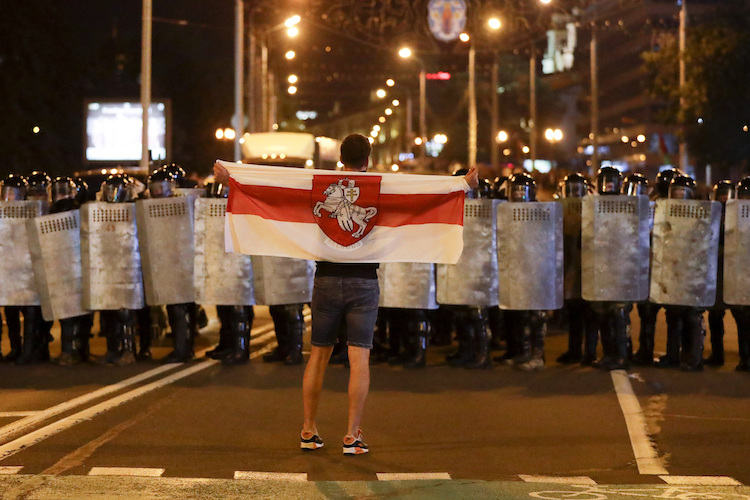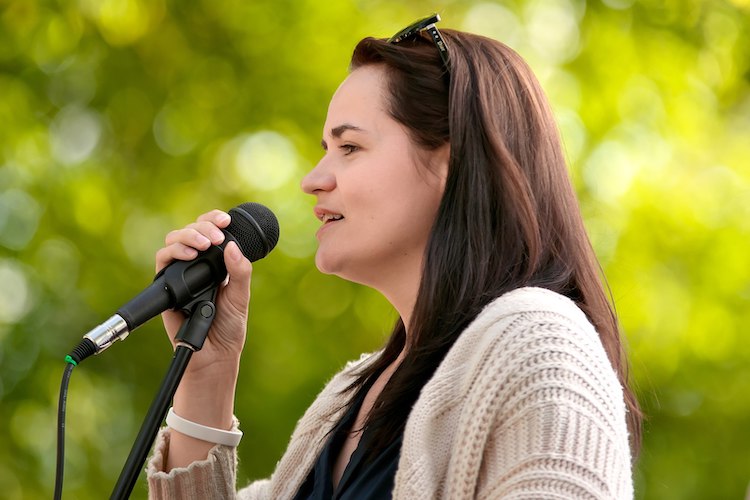The post-election protests gripping Belarus now are part of an established cycle of rigged elections and street mobilization spanning twenty years. President Alexander Lukashenko may survive this challenge: last night, his key opponent, Svetlana Tikhanovskaya, was forced to leave the country. But her campaign captured the public’s desire for change that will likely bring about the end of the regime.

August 10, 2020: Protests erupted across Belarus following the fraudulent presidential election, in which the incumbent Alexander Lukashenko claimed over 80 percent of the vote. Photo: Sergei Grits (AP Photo).
On August 9, Alexander Lukashenko was declared the official winner of the presidential election in Belarus with 80.08 percent of the vote. The election result is widely considered to be the product of fraud. Lukashenko, who has been president of Belarus since 1994, was competing against Svetlana Tikhanovskaya, a previously unknown but popular challenger, representing a coalition of opposition forces. She allegedly received 10.09 percent of the vote.
The announcement of Lukashenko’s victory was met immediately with widespread protests that were repressed by security forces in major cities. Three thousand people were detained across the country, at least one fatality was recorded in Minsk. More protests and a general strike are set to take place in the coming days.
A cycle of rigged elections, protests, and repression has characterized Belarus’ political life for decades. Belarus’ political system is set up to pit a weak opposition against a strongman head-to-head. While the outcome of the current struggle is unclear, 2020’s electoral contest appears to be unique and may prove to have irrevocably damaged the regime’s durability whether or not Lukashenko manages to hold on to power.
Lukashenko’s endurance—he’s the longest serving post-Soviet president—has been explained with reference to ideology, the continued availability of robust social benefits, and a strong security apparatus.
While he entered politics on a platform of anti-corruption and reform, Lukashenko quickly reclaimed Soviet symbols in the mid-1990s, restoring both the Soviet flag and anthem. These symbolic measures fueled an official positive interpretation of Soviet history that connected with the promise of continued stability under Lukashenko’s leadership. Belarus also largely escaped the economic upheaval caused by market reforms in other post-Soviet states. The level of social welfare provision (including subsidies on water, heating, and gas, state-regulated prices on some food items, pension increases, and free health and education) and state support for industry is both high and highly popular. However, more recent changes such as increased reliance on fixed-term contracts that lessen the bargaining power of employees and the “parasite tax” on the unemployed introduced in 2015 seem to have diminished the draw of Lukashenko’s economic appeal. Lastly, Belarus’ security apparatus remains unreformed and expansive, reaching into most populated centers and institutions. Political scientists Lucan Way and Steven Levitsky have argued that Belarus engages in low intensity coercion of opposition forces that consists of surveillance, harassment, short-term detention, and targeted criminal prosecutions.
Lukashenko’s staying power is also the result of a political system designed to exclude all other organized political forces. Unlike other post-Soviet leaders, notably Russia’s Vladimir Putin, Lukashenko has stayed in power without relying on a pro-regime governing party. Instead, he has officially disempowered political institutions in favor of ruling through presidential decrees. As a consequence of these two factors—Lukashenko’s rejection of a party of power and his declawing of other political institutions—political parties, even Soviet legacy ones, like the Communist Party, have attracted few voters. For example, only 21 of the 110 seats in Belarus’ parliament, the House of Representatives, were captured by members of political parties in 2019.
Unlike other autocrats who hold regular elections, Lukashenko has not made an effort to use potential access to the political system as a tool to co-opt political forces that may exist in society. Here again, Russia, where so-called “systemic political parties” both lend an aura of legitimacy to elections and benefit from being included in governing institutions, is an instructive comparison. In Russia, the participation of such political parties lowers the stakes of each election by syphoning votes in different directions. Putin still emerges as the victor, but other parties and candidates make an appeal to voters thereby providing stability to the system. By contrast, Lukashenko has made every legislative and presidential election in Belarus a zero-sum game in which the winner takes all, and the loser is arrested.
Given the framework of Belarus’ political system, regular cycles of rigged elections, opposition protests, and repression are the norm. Konstantin Ash, a professor at the University of Central Florida, has written about how a fragmented opposition in Belarus has been subjected to waves of arrest and detention following each election cycle. He notes that there were 309 days of post-election protest in Belarus between 1994 and 2011 that led to the arrests of nine of the 17 participating presidential candidates.
The rigging of the August 9 presidential election and the protests that have erupted in its aftermath in Belarus are neither unusual nor surprising. Yet the presidential campaign itself was unique, and its consequences may be significant.
First, Lukashenko’s popularity seems to have been negatively affected by his handling of the coronavirus pandemic. Reliable public opinion data in Belarus does not exist because the only remaining independent polling institute was shut down in 2016 after reporting that support for Lukashenko was at 29.5 percent. But an informal poll done by independent media in June 2020 showed just three percent support for Lukashenko, prompting a series of memes and jokes to spread on social media. It’s difficult to say with certainty what accounts for the decline in support, but it’s plausible that Lukashenko’s attitude toward the coronavirus—which he suggested wasn’t serious and could be cured by drinking vodka, riding a tractor, and going to the sauna—seriously damaged his image among Belarusians. His callous comments appeared tone-deaf especially as compared to reports of grassroots efforts to help people and the healthcare system deal with the virus.
Second, the opposition’s message, if not its form, is markedly different than it was before. Opposition forces have tried to unite and present a single candidate in previous campaigns. In 2001, with the help of international observers, the opposition chose Vladimir Goncharik, a union leader who was not associated with any single party. However, that campaign was undermined when Lukashenko changed the electoral code. In 2006, the United Democratic Movement chose Alexander Milinkevich, but his campaign was seriously hobbled by administrative constraints. In 2010, the opposition tried a different approach and ran nine candidates, seven of whom were arrested in the aftermath.

Belarusian presidential candidate Svetlana Tikhanovskaya delivers a speech in Vitebsk. Photo: Serge Serebro, Vitebsk Popular News (via Wikimedia Commons).
This time, the regime’s actions once again forced the opposition into a coalition. Svetlana Tikhanovskaya emerged as the opposition’s candidate after the other viable candidates, including her husband, the popular YouTube blogger Sergei Tikhanovsky, were denied registration and arrested. She was joined by members representing two other popular opposition forces to form an appealing all-female trio who put forward a populist message of growth and prosperity arguing for cultural acceptance and friendship with both Western countries and Russia. They invoked the way that the coronavirus brought people together and highlighted how little the state cared for the people. The opposition’s overall message was simple: the people have had enough of those in power not respecting them; they want change. The message was spread widely via the Internet and social networks and was reinforced with calls to adopt public symbols. Opposition voters were encouraged to wear white ribbons and fold their ballots six or eight times to make them stand out in the ballot boxes. These actions helped build a sense of solidarity among opposition voters.
The public reception of the opposition campaign was perhaps the single biggest difference between this and previous election cycles. Tikhanovskaya and her partners attracted thousands of people in small and large cities across the country for weeks. Even when the authorities canceled their last campaign events in Minsk, people turned other public events into campaign rallies in support of the opposition.
The campaign has revealed Lukashenko’s deep unpopularity, but whether this will transform into regime change is difficult to predict. Belarus has entered a dangerous time as protesters face of with security forces in the streets. So far, regime forces have avoided using deadly force although they employed water cannons, rubber bullets, and flash grenades against peaceful crowds. If things become desperate, Lukashenko may order his forces to shoot protesters or he may, like Ukraine’s Victor Yanukovich, flee in the face of street protests. However things turn out in the short term, Lukashenko is approaching the end of his stay in power.

